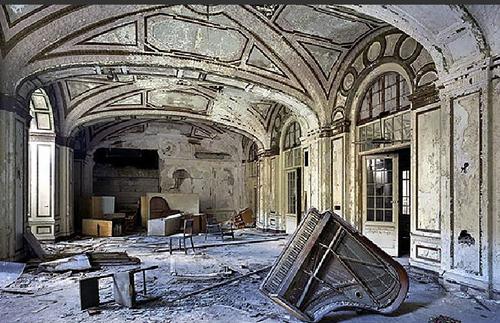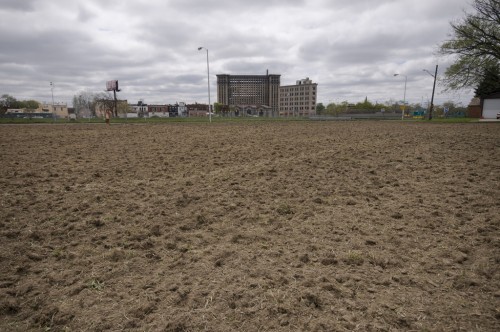Random
Geography Thursdays #1: The Rise and Decline of Detroit

Rotting building in Detroit, photo by Yves Marchand and Romain Meffre, from their Time Magazine series (click on the picture to see all the photos)
This is the first installment of a regular feature. Every Thursday, Lily Hoang and I will be bringing the news from the world of geography. First up is the most beautiful piece of writing about a city I have ever read — Rebecca Solnit’s “Detroit Arcadia,” which first appeared in Harper’s, but which now seems to be available through a link from the James & Grace Lee Boggs Center to Nurture Community Leadership. The thesis, or one of them, is that Detroit has completed the usually epochal life cycle of a major city, from rise to decline, in a hundred years:
After the Panic of 1893, Detroit’s left-wing Republican mayor encouraged his hungry citizens to plant vegetables in the city’s vacant lots and went down in history as Potato Patch Pingree. Something similar happened in Cuba when the Soviet Union collapsed and the island lost its subsidized oil and thereby its mechanized agriculture; through garden-scale semi-organic agriculture, Cubans clawed their way back to food security and got better food in the bargain. Nobody wants to live through a depression, and it is unfair, or at least deeply ironic, that black people in Detroit are being forced to undertake an experiment in utopian post-urbanism that appears to be uncomfortably similar to the sharecropping past their parents and grandparents sought to escape. There is no moral reason why they should do and be better than the rest of us, but there is a practical one. They have to. Detroit is where change is most urgent and therefore most viable. The rest of us will get there later, when necessity drives us too, and by that time Detroit may be the shining example we can look to, the post-industrial green city that was once the steel-gray capital of Fordist manufacturing. (Click here for PDF Full Text of Solnit Article.)
More Detroit photos here (urban prairies, etc.), from James D. Griffioen: http://www.jamesgriffioen.net/index.php?/prairies/new-work/ (or click the photo below)
Tags: detroit, post-urbanism, Rebecca Solnit


http://en.wikipedia.org/wiki/File:Arrested-Expansion.jpg
The D isn’t gonna improve noticeably until people start talking about how it’s improving noticeably. Money will then be poured. Till then, well. Hide ya kids, hide ya wife
Excellent.
Detroit as Julian-and-Maddalo, post-American desolate place seems to be a popular take on the situation these days.
Harper’s seemed to be on it a few years back.
They published a Detroit Public Schools Book Depository photo by this fellow, in May 2008, ten months after the Solnit piece:
http://www.jamesgriffioen.net/
Thank you for that link. I’m going to add it to the main post
epochal life cycle of a major city, from rise to decline
Athens and Rome: somewhat ‘back’ from Dark Ages. Mycenae, Angkor Wat, and Tikal: not so much.
The differences between flatline and bounce-back? (Or do most political-economic geographers take the imaginary-long view that for nowhere are things ‘over’?)
You’re right — I oversimplified the summary.
isn’t Detroit already making a comeback? matthew barney just did an opera there last weekend, and there are some other good ‘up and coming’ artists based there. michael e. smith for instance.
wouldn’t the point be that money is being invested in the city again? i.e. a matthew barney opera doesn’t cost peanuts -and alot of that was invested directly into the local economic structures (the barney opera used the steel mill as its site and, erm, wasn’t ‘cheap’). i’ve also heard of people (in the techno/art crowds) who were there saying detroit’s the next berlin. i.e. ‘poor but sexy,’ i.e. ‘up and coming.’ dunno. it just seemed to me that a dead city, in the sense of mike davis, wouldn’t have these sorts of lively projects.
Not sure about what I’m “right”, Kyle – I meant the questions literally!
I think cities, like geographically larger states and more extensive civilizations, do ‘rise and decline’. But sometimes there’s survival past the decline, a persistent ember that could kindle a revival, and sometimes there’s surrender, abandonment, cultural reversion or re-direction that goes away from that “city”, that geography.
Well said.
I think the latter would be much less likely in a former major US city, at this point in history anyway, than it would elsewhere. Some of the photos by Griffioen and Marchand/Meffre suggest it’s over. But I think, eventually, the economic incentives become too great with US cities – this seems to be the pattern, anyway – and this often leads to a reversal or limited reversal. Not suggesting that Detroit will rise to become what it was. That would be impossible. Or that it might experience a limited revival. But I think there is hope – also expressed in the work of Griffioen, as an example, who lives there – that the city might bounce back. A lot of factors, of course. But possible. As noted below by Shane Anderson: artists settling in. This is how other revivals have begun. Got a long way to go, though.
Nice. I think people who read this blog might be particularly interested in the Detroit Public Schools Book Depository photos. See: left-hand menu on home page.
I don’t know if you can make the connection between some art happenings and the economic revitalization of a city. Plenty of great artists in all sorts of dead cities.
wouldn’t the point be that money is being invested in the city again? i.e. a matthew barney opera doesn’t cost peanuts -and alot of that was invested directly into the local economic structures (the barney opera used the steel mill as its site and, erm, wasn’t ‘cheap’). i’ve also heard of people (in the techno/art crowds) who were there saying detroit’s the next berlin. i.e. ‘poor but sexy,’ i.e. ‘up and coming.’ dunno. it just seemed to me that a dead city, in the sense of mike davis, wouldn’t have these sorts of lively projects.
Good post, Kyle! I like this idea of Geography Thursdays.
Have you read James Howard Kunstler’s The City in Mind? I don’t think he does Detroit in there, maybe he does and I’m forgetting, but anyhow, it’s a book about urban spaces, and his depiction of Vegas, as I remember it, was pretty spot on. You might like it.
Chris, I haven’t, but I will.
Detroit gets a bad reputation b/c the situation of abandonment and disrepair is more pervasive and the scale of disaster is larger because of Detroit’s larger historic and present size. But it is only the most severe end of a spectrum of economic failure that is apparent throughout the urban midwest, in a band stretching from Buffalo to KC. Almost every city in that band has lost half its peak population and contains vast swaths of blight very similiar to the wide-spread and much-publicized kind one sees in Detroit.
Meanwhile many rural and small towns, from Appalachia to the Rockies, make Detroit look like San Francisco.
Both situations have the same root cause, and there will be no widespread “comeback” for our cities or our small towns until the perpetrator of the devastation — consumer capitalism and its cold war on the agrarian and urban working class — is addressed.
Kudos to the “urban pioneers” and art kids in Detroit, STL, Cleveland, etc., but people who think Portland-style focus on luring the “creative” class is a sustainable solution for the modern American city are usually delusional or under 30 years old. And, while certainly a nice ammenity to have for a small segment of the oi polloi, no arts scene will ever sufficiently offset the need for cities to serve primarily as agglomerations of places to work.
Well said, Craig Davis.
Detroit gets a bad reputation b/c the situation of abandonment and disrepair is more pervasive and the scale of disaster is larger because of Detroit’s larger historic and present size. But it is only the most severe end of a spectrum of economic failure that is apparent throughout the urban midwest, in a band stretching from Buffalo to KC. Almost every city in that band has lost half its peak population and contains vast swaths of blight very similiar to the wide-spread and much-publicized kind one sees in Detroit.
Meanwhile many rural and small towns, from Appalachia to the Rockies, make Detroit look like San Francisco.
Both situations have the same root cause, and there will be no widespread “comeback” for our cities or our small towns until the perpetrator of the devastation — consumer capitalism and its cold war on the agrarian and urban working class — is addressed.
Kudos to the “urban pioneers” and art kids in Detroit, STL, Cleveland, etc., but people who think Portland-style focus on luring the “creative” class is a sustainable solution for the modern American city are usually delusional or under 30 years old. And, while certainly a nice ammenity to have for a small segment of the oi polloi, no arts scene will ever sufficiently offset the need for cities to serve primarily as agglomerations of places to work.
Well said, Craig Davis.
Yes, Detroit’s former cultural primacy; the fact that it was once the fourth-largest city in the US of A – after New York, Chicago, and Philadelphia; was the car-making capital of the world once; a manufacturing behemoth. All these and other reasons make it an oft-cited example – a symbol – for American urban abandonment/despair. After a while, it becomes cliche. But it is for these reasons that I’d give Detroit a chance. Cities that have or had these attributes/characteristics seem to have a better shot at revival. I don’t know about KC, but old manufacturing towns in upstate NY: lost forever, in my opinion. Buffalo, Rochester, Schenectady. The New Yorker just ran a piece about a loan collector in Buffalo. If an accurate portrayal, pretty dire. Newark is perpetually making a comeback, but never seems to make it, like Brooklyn has. I understand Pittsburgh has seen an modest revival. There hasn’t been steel made in Pittsburgh proper in decades.
[…] Giant’s post on Detroit reminded me of a conversation I’d had about three years ago, not long after I’d found a […]